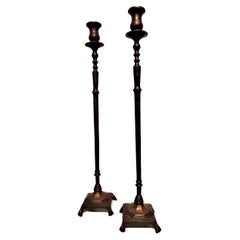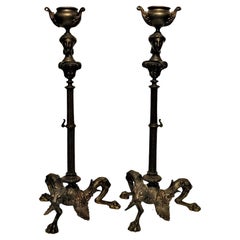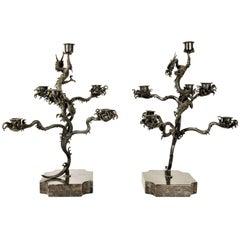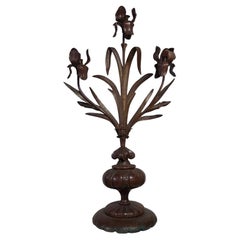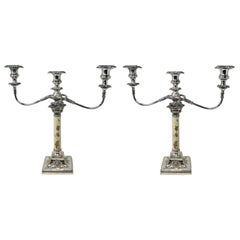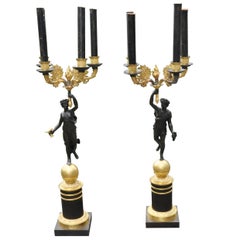Ashville Fine Arts Candle Holders
10
to
10
10
10
10
2
1
1
6
4
3
1
1
1
1
Height
to
Width
to
9
6
2
1
1
5
4
4
2
1
1
1
Antique Italian Wrought Iron Dragon Candle Holder, XIX Century
Located in New York, NY
Antique
Candle Holder in form of a Dragon
Wrought Iron
Italy, XIX Century
ABOUT
This unique and really whimsical wrought iron candle holder in the form of a stylized dragon immediat...
Category
Antique 1890s Italian Medieval Candelabras
Materials
Wrought Iron
Aesthetic Movement Pair of Bronze Candlesticks in Manner of Tiffany, ca. 1880s
Located in New York, NY
American Aesthetic Movement
Pair of Bronze Candlesticks
in Manner of Tiffany
ca. 1880s
DIMENSIONS
Height: 18.25 inches
Width: 3.25 inches
Depth: 3.25 inches
ABOUT
This elegant pa...
Category
Antique 1880s American Aesthetic Movement Candlesticks
Materials
Bronze
A Pair of Bronze Neoclassical Grand Tour Candelabras, Late 19th Century
Located in New York, NY
Grand Tour
Pair of Bronze Candelabras
Late 19th Century
DIMENSIONS
Height: 10.33 inches
Width: 4.75 inches
Depth: 4.75 inches
ABOUT
We present to your attention a pair of stunning...
Category
Antique 1890s English Grand Tour Candelabras
Materials
Bronze
Pair of Japanese Patinated Bronze Candelabras, Meiji Period, ca. 1900
Located in New York, NY
This most unusual pair of original 18th century Japanese patinated bronze candelabras, uniquely designed as branches of mountain flowers entangled by a dragon, are mounted on the con...
Category
Antique Late 19th Century Japanese Japonisme Candelabras
Materials
Bronze
French Art Nouveau Grand Bronze Iris Candelabra, ca. 1900
Located in New York, NY
ABOUT IRIS MOTIFS
Iris motifs were popular during the Arts & Crafts movement. The genus of this easy-to-stylize flower has nearly 300 varieties that bloom in many colors—thus its nam...
Category
Antique Early 1900s French Art Nouveau Candelabras
Materials
Bronze
A Pair of Art Deco Ceramic Candle Holders by Roockwood Pottery, ca. 1920
By Rookwood Pottery Co.
Located in New York, NY
MARKINGS
Each candle holder is fully marked on the bottom, including date XX (ca. 1920) and model number (2304).
ROOCKWOOD POTTERY
Roockwood is the synonym of the American Art Pottery. Founded on Thanksgiving Day in 1880 by Maria Longworth Storer, Rookwood made history – the first large manufacturing enterprise founded and owned by a woman in the United States and launching the art pottery movement in America. Within a decade, Rookwood pottery gained international acclaim, rivaling European and Asian firms that had been in existence for hundreds or thousands of years.
Maria Longworth Nicholas, was the daughter of a wealthy art collector, she was inspired by Japanese pottery. When she discussed her desire to create fine pottery with her father, he provided the means and environment that allowed her to pursue her creative passions. And although it may have started as a hobby, the talented Maria quickly managed to establish Rookwood pottery as a quality producer of fine ceramic art potter.
She setup the Rookwood company, hired artists like Japanese artist Kataro Shirayamadani who came to work for the company in 1887, and talented art students and encouraged them to use their creativity to experiment and create unique pottery pieces. Almost every piece designed by these artists sold for hundreds of dollars, and today they are regarded as highly collectible. A Rookwood piece by Japanese artist Kataro Shirayamadani sold for $198,000 in 1991. He was a Rookwood artist from 1887 until 1948.
The Rookwood airbrush, called the mouth atomizer, was developed by Rookwood to apply glazes in an innovative way. The technique helped the company develop its own individual look. The atomizer helped add the beautiful layers of color Rookwood is known for, and the technique is still used at the Rookwood pottery today.
More well-known pottery manufacturers and recognized artists doubted this female led company would have what it takes to succeed, but much to their surprise Rookwood turned out to be one of the best. By combining extraordinary attention to detail and innovative design Maria Longworth Nicholas made Rookwood the standard for ceramic pottery manufacturers to aim for.
Today antique and vintage Rookwood Pottery...
Category
Vintage 1920s American Art Deco Candlesticks
Materials
Ceramic
WMF, German Jugenstil, a Pair of Copper & Brass Candlesticks, Ca. 1910
By WMF Ikora
Located in New York, NY
DETAILS
Marked on bottom.
WMF GmbH
In 1853, mill owner Daniel Straub, together with the Schweizer brothers, Louis and Friedrich, established the Straub & Schweizer metal works in Geislingen an der Steige, Germany. Only a few years later in 1862, their silver-plated tableware and serving dishes were awarded a medal of distinction at the world exhibition in London. The company, originally called Metallwarenfabrik Straub & Schweizer, merged in 1880 with Ritter & Co - a producer of high end luxury items who were ahead of their time in silver plating technique.
Instead of using the method of heat and mechanical pressure to plate their wares, Ritter dipped the item into a bath of silver which together with an electric current produced pieces that were finely and evenly covered in a layer of silver. This method of plating was called ‘Galvanisation’ and allowed more intricate and complex pieces to be plated.
After several years both companies still faced financial problems and in 1880 they joined with the Wurttemberg Union Bank and the company was renamed “WMF” (Württembergische Metallwarenfabrik). From its founding as one company, WMF's growth was tremendous - acquiring more factories along the way, notably including "Orivit AG" and "Orion KM". By the end of the 1900's, they were the world's largest producer and exporter of household metalware.
WMF started making glass in 1883 when a glass house was built at Geisslingen near Stuttgart to produce their own glass inserts. The original 1883 glass house was destroyed during the First World War and a new, more modern facility opened in 1922. The young glass designer Karl Wiedmann perfected the technique of iridized surfaces and the resulting "MYRA"- Kristall entered production in 1926. The same year also saw the beginning of the first "IKORA" glass - reputedly discovered by accident whilst correcting a Myra glass...
Category
Vintage 1910s German Jugendstil Candlesticks
Materials
Brass, Copper
Pair of American Rococo Revival Patinated Bronze Candelabras, Ca. 1825
Located in New York, NY
Bronze, dark-brown patina, unmarked.
Measures: Height: 23”
Width: 14”
The notion of an “American Rococo” seems a contradiction in terms. The very word rococo is as French as Camembert. It connotes a style that reigned along with Louis XV in the aristocratic decadence of the 18th Century. It was garlanded, nonchalant, associated with erotic marshmallow nudes by Francois Boucher and foppish courtiers costumed as shepherds pretending they understood Jean-Jacques Rousseau when all they really wanted was romantic dalliance in the formal gardens of Versailles. In the history of painting it produced but one great artist, Antoine Watteau.
By contrast, Americans of the period are remembered as the flinty inheritors of New England Puritans, full of rectitude and having not a moment for furbelow or frippery. Such few painters as were around included hard-nosed realists like John Singleton Copley and Charles Willson Peale.
Well, as it turns out, life once again acts according to the principle of paradox. There was an American rococo. It came to us indirectly via England disguised under the name Chippendale. Now for the first time the style receives comprehensive survey in the exhibition “American Rococo, 1750-1775: Elegance in Ornament.” Jointly organized by New York’s Metropolitan Museum and the Los Angeles County Museum of Art, it opens here Sundaywith a spread of some 170 works of decorative art and a conscientious catalogue with essays by Met and LACMA curators Morrison H. Heckscher and Leslie Greene Bowman.
There are at least two ways of looking at the decorative arts. Connoisseurs appreciate their design and craftsmanship. Those of sociological bent examine objects of material culture for their revelations of history and the temper of the times. Actually neither view is complete without the other.
Stylistically the rococo reveals a longing for intimacy in its small scale and an urge to organic nature in its love of stylized vines, tendrils, tiny flowers and seashells. If it were a new manner being promoted by Madison Avenue today it would probably be called “Baroque Lite.” There is an ease about the style that makes it airy, but it has an underlying formality that bespeaks lives of gentrified cultivation rather than beer-bellied sloth. It’s fascinating to examine the flintlock firearms on view and find these weapons of death shaped and decorated with the most exquisite care by wood carvers and metal engravers.
All of this is completely consistent with the main currents of 18th-Century European thought. In France, Rousseau sang the virtues of nature and the noble savage like a present-day ecologist. In England, John Locke...
Category
Antique 1820s American Rococo Revival Candelabras
Materials
Bronze
Pair of Mid-Century Modernist Anodized Brass Lotus Candlesticks, USA, 1950s
Located in New York, NY
A duo of anodized brass candlesticks, each featuring a round base, stem and a lotus flower that contains a regular size candle. Manufactured in the USA during the 1960s.
The cand...
Category
Mid-20th Century American Mid-Century Modern Candlesticks
Materials
Brass
La Cruche Casee, Antique French Bronze Sculptural Desk Candleholder, circa 1875
Located in New York, NY
The inscription engraved on the gilded medallion in the center of the plinth serves as the name of this remarkable sculpture, La Cruche Casee (The Broken Jug). Made of multicolored patinated and ormolu bronze in the second half of the 19th century France, this absolutely fabulous stationary figural candle...
Category
Antique 1870s French Romantic More Candle Holders
Materials
Bronze
Related Items
Pair Estate English Aesthetic Movement Silver-Plated Candlesticks Circa 1950-60.
Located in New Orleans, LA
Pair Estate English Aesthetic Movement Silver-Plated Candlesticks, Circa 1950-1960.
Category
Mid-20th Century English Aesthetic Movement Candlesticks
Materials
Silver Plate
H 17 in W 17 in D 4.75 in
Pair of Empire Gilt and Patinated Bronze Candelabra
Located in Essex, MA
Pair of 19th century gilt and patinated bronze candelabra now as lamps. Figural Baccantes holding torchieres. Empire or Charles X ...
Category
Antique Early 19th Century French Empire Table Lamps
Materials
Bronze, Ormolu
Pair of Art Deco Tree Shaped Wrought Iron Candle Holders Torchieres
Located in Saarbruecken, DE
Pair of French Art Deco Tree Shaped Wrought Iron Candle Holders Torchiers Candelabra
Exceptional Hand crafted Iron Work from around 1930-1940, France in the style of Poillerat. Ho...
Category
Vintage 1940s French Art Deco Candle Holders
Materials
Iron
Pair of Bronze Candlesticks, Louis XV
Located in Saint-Ouen, FR
Pair of bronze candlesticks, Louis XV
Nice pair of 18th century gilt bronze and porcelain candlesticks from Italy,
The frame dates from t...
Category
Antique 19th Century Italian Louis XV Candlesticks
Materials
Bronze
Mid-Century Modernist Japanese Iron Candle Holder
By Isamu Noguchi
Located in San Diego, CA
A wonderful mid-century modernist Japanese iron candle holder, circa 1950s. The piece is in good vintage condition with a nice patina and measures 4.75"D x 1.5"H. Very cool piece! ...
Category
Mid-20th Century Japanese Mid-Century Modern Candlesticks
Materials
Iron
A Japanese Meiji Period Patinated Bronze Censer
Located in Stamford, CT
A Japanese Meiji censer rising on three stylized Foo Dogs feet with Frog form handles. Censer having exceptional patination.
Acquired from Michael Goedh...
Category
Antique Late 19th Century Japanese Meiji Planters, Cachepots and Jardini...
Materials
Bronze
Pair of French Charles X Patinated Bronze and Gilt Figurative Candelabras
Located in Dallas, TX
A fine pair of figurative candelabras in the form of a patinated bronze cherub running with a gilt torchiere in each hand. The cherubs stand on a...
Category
Antique Early 18th Century French Charles X Candelabras
Materials
Marble, Bronze
Mid-Century Modernist Japanese Iron Candle Holders
By Isamu Noguchi
Located in San Diego, CA
A pair of wonderful iron candle holders from Japan. Triangular form supported by a tripod base. Great patina. 1950s.
Category
Mid-20th Century Japanese Mid-Century Modern Candlesticks
Materials
Iron
Mid-Century Modernist Japanese Iron Candle Holder
By Isamu Noguchi
Located in San Diego, CA
A wonderful mid-century modernist Japanese iron candle holder, circa 1950s. The piece is in good vintage condition with a nice patina and measures 4"D x 1.5"H. Very cool piece! #3358
Category
Mid-20th Century Japanese Mid-Century Modern Candlesticks
Materials
Iron
Primitive 19th Century Wrought Iron Candle Holder
Located in Mjöhult, SE
Primitive and rather large 19th century wrought iron tripod candle holder with a fixed socket and a sprung Jaw holder for use of the last stump of...
Category
Antique 19th Century Swedish Folk Art Candelabras
Materials
Iron, Wrought Iron
Modernist Wrought Iron Candle Snuffer
Located in Chicago, IL
A beautiful wrought-tin candle snuffer with a modernist vibe including two fins around a central knuckle, and ending in a ball finial.
Category
20th Century American Modern More Candle Holders
Materials
Wrought Iron
Art Nouveau French Brass Floral Candelabra, circa 1900
Located in Pearland, TX
A gorgeous antique Art Nouveau French solid brass candelabra with four candle holders. This stylish candelabra is solid and heavy, weighing a substantial 3 lbs 10 oz, with a beautifu...
Category
Antique Early 1900s French Art Nouveau Candelabras
Materials
Brass

